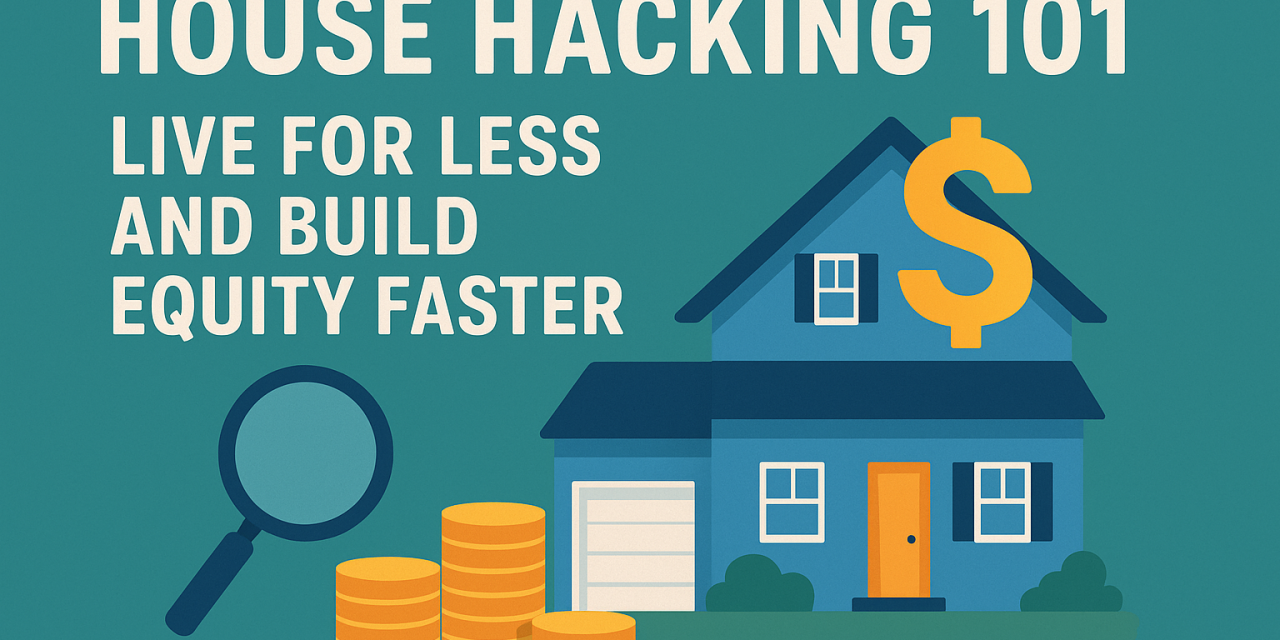House Hacking 101: Live for Less and Build Equity Faster
House hacking is a simple idea with outsized results: buy a home, live in one part, and rent the rest to offset your mortgage. Done well, you reduce living costs, accelerate equity, and set up your next property purchase.
What Is House Hacking?
House hacking is owner-occupied real estate investing. You purchase a property, live in part of it, and rent out the remaining space—bedrooms, an accessory dwelling unit (ADU), or separate units in a duplex/triplex/fourplex. The rental income covers some or all of your mortgage and expenses, allowing you to live for less while building equity.
Why House Hack: Key Benefits
Lower Cost of Living
- Tenants’ rent offsets principal, interest, taxes, insurance, and utilities.
- “Live for less” or even “live for free” in stronger rental markets.
Faster Equity
- Amortization + potential appreciation, paid in part by rental income.
- Ability to save cash for the next down payment.
Loan Advantages
- Owner-occupied loans often require lower down payments and rates than standard investment loans.
- Up to four units can qualify as residential in the U.S.
Skill Building
- Learn screening, leasing, maintenance, and budgeting on a small scale.
Popular Strategies
- Rent-by-the-room in a single-family home: Highest income per square foot; requires clear house rules.
- Duplex/Triplex/Fourplex (“small multifamily”): Separate entrances and meters simplify living with tenants.
- ADU/Garage apartment/Basement suite: Private space for you or your tenant; check zoning and egress requirements.
- Short-term/mid-term rentals: Potentially higher gross income; more turnover and local rules to follow.
- Live-in flip + rooms: Improve the property while collecting rent; mind permit and resale timelines.
Financing Options (U.S.)
- FHA (3.5% down): Allows 1–4 units; mortgage insurance applies. Some lenders count projected rental income toward qualifying.
- Conventional (as low as 3–5% down for owner-occupied): Competitive rates; private mortgage insurance can drop later.
- VA (0% down for eligible borrowers): Powerful option for 1–4 units if you’ll occupy one unit.
- FHA 203(k) or conventional renovation loans: Finance purchase plus rehab into one loan; helpful for adding bedrooms/ADU.
Important: Owner-occupied loans generally require you to move in within a set period and live there ~12 months. Always confirm your lender’s occupancy rules before closing.
The Numbers: A Simple Example
Assume you buy a $420,000 triplex with 5% down at a 6.5% interest rate, 30-year fixed. Taxes/insurance: $6,000/yr. Estimated maintenance/capex reserve: 8% of rents.
| Item | Monthly |
|---|---|
| Loan amount (approx.) | $399,000 |
| Principal & Interest | $2,520 |
| Taxes & Insurance | $500 |
| Total PITI | $3,020 |
| Unit A rent | $1,450 |
| Unit B rent | $1,400 |
| Gross rent (you live in Unit C) | $2,850 |
| Maintenance/CapEx (8% of rent) | −$228 |
| Net before utilities | $2,622 |
| Your effective housing cost | $3,020 − $2,622 = $398 |
Result: You live for under $400/month while building equity. If you later move out and rent your unit for $1,450, the property may turn cash-flow positive while you keep the original financing.
Finding the Right Property
- Layout: Separate entrances, split bedrooms, or easy ADU potential.
- Zoning & permits: Confirm legality of ADUs, duplex use, parking requirements, and egress for bedrooms.
- Mechanical systems: Separate utilities are ideal; if shared, add a utility reimbursement system.
- Neighborhood demand: Near transit, hospitals, universities, or job centers for reliable tenants.
- Condition: Target properties where low-cost improvements add rentable bedrooms/baths.
Operations: Tenants, Leases, House Rules
Screening
- Written criteria: income, credit, rental history, background checks where permitted.
- Consistent process to comply with fair housing laws.
Leases
- Use state-specific leases; include house rules as an addendum.
- Define shared areas, quiet hours, cleaning rotations, and guest policies.
Money & Maintenance
- Online rent collection; late-fee policy; utility reimbursements via RUBS or flat fees.
- Schedule quarterly maintenance walkthroughs and filter changes.
Privacy & Boundaries
- Deadbolts on bedrooms; lockable owner closet; separate Wi‑Fi networks if possible.
- Notice before entry per state law (often 24 hours).
Risk Management and Reserves
- Cash reserves: Target 3–6 months of expenses including mortgage.
- Insurance: Ensure correct policy type for owner-occupied rental; add liability coverage.
- Vacancy plan: Keep a waitlist; advertise proactively 30–60 days before move-outs.
- Interest rate risk: Favor fixed-rate financing; avoid over-leverage.
- CapEx roadmap: Roof, major systems, and appliances—budget their remaining life.
Taxes and Compliance
- Deductions: You may deduct expenses attributable to the rented portion (and depreciate it). Track square footage and direct vs. shared costs.
- Primary residence benefits: Potential mortgage interest deduction; possible capital gains exclusion when you sell if you meet IRS use tests.
- Local rules: Some cities regulate rooming houses, ADUs, and short-term rentals; register if required.
- Records: Keep separate bookkeeping for the rental portion from day one.
Not tax, legal, or lending advice. Consult a qualified pro in your state before you buy or list rooms.
Exit Plans and Scaling Up
- Stay-put cash flow: Keep living in the property and bank the savings.
- Move-out convert: After meeting occupancy requirements, rent your former unit and keep the loan.
- Live-in flip: Sell after upgrades if market conditions favor it.
- BRRRR-lite: Refinance after forced appreciation to reduce payment or fund the next down payment.
- Stacking: Repeat every 12–24 months to build a small portfolio of 1–4 unit properties.
Ways to Boost Income
- Lease by the bedroom with individual leases and locks.
- Add value: in-unit laundry, fenced yard, off-street parking, furnished rooms.
- Charge for storage, pet rent, premium Wi‑Fi, or a cleaning fee where permitted.
- Mid-term rentals for traveling professionals (furnished, 30–90 day stays).
- Install separate meters or sub-meters where feasible to normalize utility costs.
Quick Checklist
- Clarify goals: live cheapest, maximize cash flow, or add value?
- Get preapproved and confirm owner-occupancy rules in writing.
- Underwrite deals with conservative rents and a vacancy factor.
- Verify zoning, permits, parking, and local rental licensing.
- Budget a renovation plan focused on rentable beds/baths.
- Create screening criteria, leases, and house rules before listing.
- Set up bookkeeping and separate accounts for the rental portion.
- Maintain 3–6 months of reserves and a CapEx schedule.
FAQs
How much down payment do I need? Many owner-occupied loans allow 3–5% down; VA is 0% for eligible borrowers. Closing costs still apply.
Do I have to live in the property? Yes, for owner-occupied financing you typically must move in within a set period and stay about 12 months. Confirm with your lender.
Is rent-by-the-room legal? It depends on local occupancy limits, licensing, and zoning. Check city and state rules and any HOA/condo restrictions.
What if tenants don’t pay? Follow your state’s notice and eviction process. Good screening and clear leases are your first defense; keep reserves.
Can I start with a single-family home? Absolutely. Many beginners start by renting spare bedrooms or finishing a basement with proper egress and permits.
Next Steps
- Speak with a local lender about owner-occupied options and preapproval.
- Define your buy box: price range, neighborhoods, unit mix, and renovation capacity.
- Analyze five candidate properties this week; make offers on the best one or two.
House hacking works when the numbers work and the rules are followed. Start small, keep great records, and let time and amortization do the heavy lifting.





